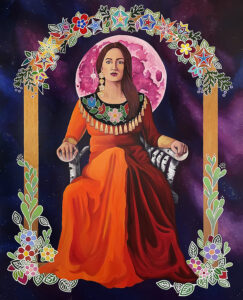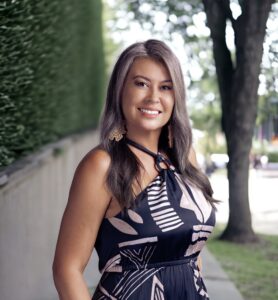Indigenous Women: Resilience and Representation by Hillary Kempenich

For Women’s History Month, we asked artist, cultural bearer, and advocate Hillary Kempenich to write on the significance, empowerment and cultural impact Native women make in our communities – highlighting the importance of Native women as culture bearers, artists, creatives and place-makers.

By Hillary Kempenich
Women’s History Month should be a platform to remind us of the intersectionality of Indigenous womanhood. To authentically move forward together as a society, we must look at how marginalization and discrimination continue to manifest and oppress Indigenous women. During this time, as we celebrate the contributions of women, we must also reflect on how we should dismantle structures that disregard and erase Indigenous women. This involves challenging one’s biases, combatting tokenism, recognizing privilege, intentional listening, decentering whiteness, and genuine learning rather than centering dominant narratives that are continually uplifted.
Indigenous women have been leaders, activists, innovators, educators, and caretakers for centuries and continue to be. We brazenly uniquely connect to land, water, ancestors, and tradition while embodying a profound sense of responsibility to our communities. Our contributions to society, culture, and history are vast and significant, yet we can often be overlooked, sidelined, dismissed, and ignored in discussions about women’s rights and achievements. As Indigenous women, our stories are a testament to the power of resilience as we continually work to protect land, water, rights, and cultural practices while advocating for restorative justice and equality.
Through my work as an artist, I utilize different methods to amplify the voices and stories of Indigenous women so that we can delve into the comprehensive understanding of women’s history. This work creates space to honor the diversity and complexity of women’s experiences across different cultures and communities. First, we must acknowledge the ongoing struggles for sovereignty, self-determination, self-healing, and cultural revitalization that many Indigenous women face today.
The wearing of many makizins, or moccasins, as an Indigenous woman comes with great privilege and responsibility. Central to the sacredness of Indigenous womanhood is recognizing our roles as caretakers, leaders, mentors, healers, community members, and stewards of cultural knowledge. We carry knowledge passed down through generations, preserving rituals, languages, and customs integral to our cultural identity. As we celebrate and reflect, we must also make space to recognize the need for self-care and healing. The demanding nature of women’s lives of adaptation and multitasking, as we seek to thrive, can carry many challenges, and we can become overwhelmed, stressed, and burned out as we strive to meet the expectations placed on us by society and ourselves.
As Women’s History Month ends, it is crucial to reflect on this past month and ask ourselves how we can be more genuinely inclusive, accepting of differences, and celebrate the impact of Indigenous women. This reflection is an opportunity to highlight the unique challenges that Indigenous women face due to colonization, diaspora, displacement, and ongoing systemic injustices while celebrating our resilience, wisdom, and collective contributions to culture and society. Exploring different perspectives is a significant starting point for finding common threads to come together in authentic solidarity collectively. Amplifying all voices of the global majority is a crucial step in creating a more equitable and inclusive society.

About the Author:
Hillary Kempenich is a multi-disciplinary artist, cultural bearer, and advocate, emphasizing her work to empower Indigenous people. Award winning artist Hillary Kempenich is a member of the Turtle Mountain Band of Chippewa. Hillary has immersed herself into sustaining her small business and continues her passion for community work. Raised on the Turtle Mountain reservation, Kempenich continues to advocate for better educational, health and cultural standards through her work in both urban and rural communities.
Hillary holds a bachelor’s degree from University of North Dakota. Kempenich serves on the Grand Forks Foundation for Education Alumni Network board of directors and the board for the future Grand Forks Children’s Museum. Kempenich is a 2023 Bush Fellow, and currently taking courses at Harvard. She serves as an arts and cultural consultant and has started the wearable art line Zazegaa Designs by Hillary Kempenich. Kempenich lives in Grand Forks, North Dakota with her family.
To learn more about Hillary’s work, visit her website at http://www.hillarykempenich.com/
